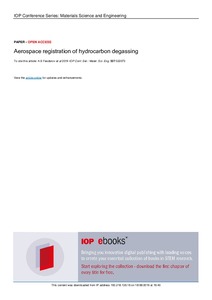Показать сокращенную информацию
Aerospace registration of hydrocarbon degassing
| Автор | Свиридов, Леонид Игнатьевич | |
| Автор | Федоров, А Б | |
| Автор | Афанасов, В И | |
| Автор | Спирин, Т С | |
| Автор | Бушкина, А В | |
| Дата внесения | 2020-01-20T07:15:54Z | |
| Дата, когда ресурс стал доступен | 2020-01-20T07:15:54Z | |
| Дата публикации | 2019 | |
| Библиографическое описание | Свиридов, Леонид Игнатьевич. Aerospace registration of hydrocarbon degassing [Текст] / Леонид Игнатьевич Свиридов, А Б Федоров, В И Афанасов, Т С Спирин, А В Бушкина // IOP Science: IOP Conf. Series: Materials Science and Engineering. — 2019. — Т. 537. — С. 1-6 | |
| URI (для ссылок/цитирований) | https://iopscience.iop.org/article/10.1088/1757-899X/537/2/022073 | |
| URI (для ссылок/цитирований) | https://elib.sfu-kras.ru/handle/2311/128811 | |
| Аннотация | An active geological study of promising areas for oil and gas is being conducted in areas where geological signs of associated hydrocarbon manifestations are detected. The development of deposits contributes to a developed system of cracks in the surrounding rocks. Fluid supply to fractured reservoirs occurs through the channels of deep faults. Prolonged winter freezing of rocks inhibits the release of gases into the Earth’s atmosphere. The accumulation of hydrocarbon gases in the near-surface cavities creates risks of gas emissions, fires and explosions. Prediction and rapid diagnosis of gas emissions is based on planetary observations from satellites of ozone concentration in the atmosphere. V.L. Syvorotkin experimentally showed a causal relationship between hydrogen degassing and the formation of “Ozone Holes”. Satellite measurements of ozone concentrations in the atmosphere allow daily monitoring of hydrogen degassing sites from the Earth’s surface. The state of the soil surface in the areas of deep degassing is determined by secondary features. These are griffins, soil emissions, ring-shaped structures of gray soil (falling fertility), and hummocks of specific morphology. Such hummocks are formed as a result of the vital activity of “Hydrogen bacteria” and are markers of gas emission on the ground. In combination, methane with hydrogen is capable of detonation at concentrations ranging from 1%. The danger increases in the presence of iron-containing minerals that can catalyze the oxidation reaction. Preventive measures are proposed to prevent the sudden release of flammable gases: by drilling a network of control waste wells with a depth of 100 to 200 meters. Such wells are similar to ventilation wells in areas of coal mining. | |
| Название | Aerospace registration of hydrocarbon degassing | |
| Тип | Journal Article | |
| Тип | Journal Article Preprint | |
| Страницы | 1-6 | |
| ГРНТИ | 38.01 | |
| Дата обновления | 2020-01-20T07:15:54Z | |
| DOI | 10.1088/1757-899X/537/2/022073 | |
| Институт | Институт нефти и газа | |
| Подразделение | Кафедра геологии нефти и газа | |
| Подразделение | Кафедра машин и оборудования нефтяных и газовых промыслов | |
| Журнал | IOP Science | |
| Квартиль журнала в Scopus | без квартиля | |
| Квартиль журнала в Web of Science | без квартиля |

